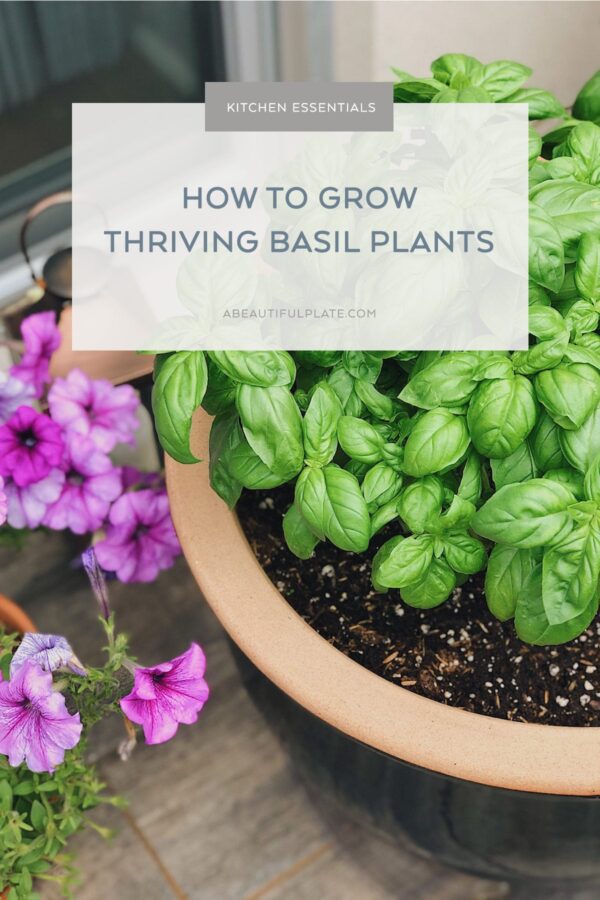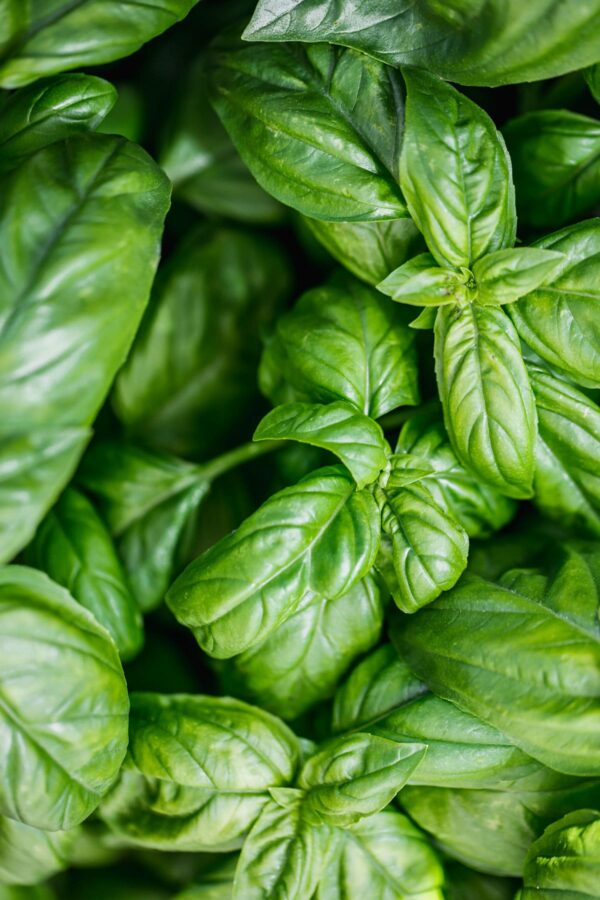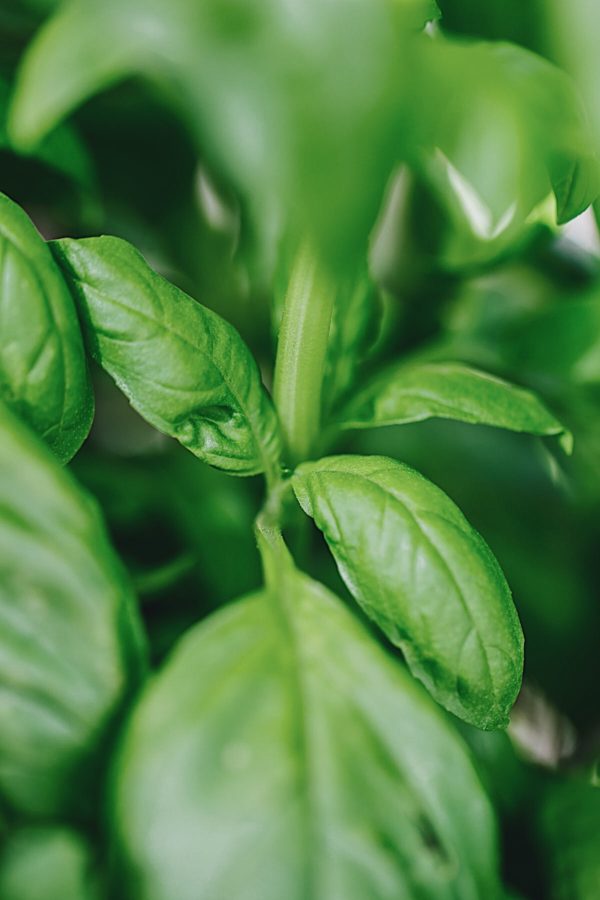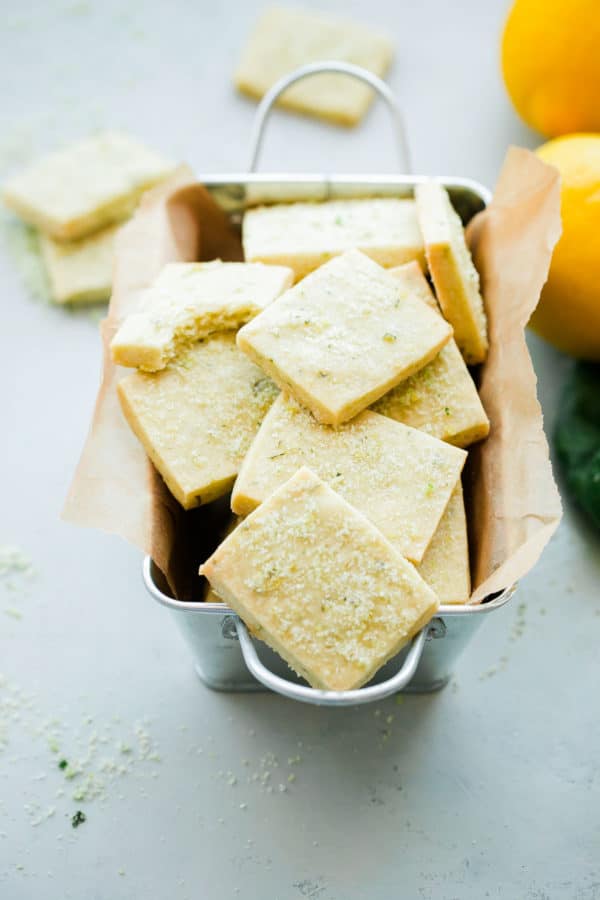How to Grow Thriving Basil at Home
How to Grow Basil (and Keep It Alive) – a resource with tips on how to grow healthy, flourishing basil plants at home.

Let’s talk plants! Since summer is quickly approaching, I thought it would be helpful to re-share last year’s guide on how to grow basil at home.
I received so many responses/questions after sharing my (extremely happy) basil plant on Instagram last summer that I wanted to make an easy resource post that you can easily reference.
You see, I’ve been a killer of most all basil plants in the past. They’ve rarely made it past a few weeks and were hardly worth the effort in yield. After moving to our new apartment last May, I vowed to try once again. Nothing makes me happier than having access to fresh basil at a moment’s notice.
Instead of blindly going into the process, I learned from past mistakes and did quite a bit of research. The results were astonishing. My basil plant thrived all summer long. Implementing just a few basic tips and practices made all of the difference.
Here are my five tried and tested tips for growing healthy, flourishing basil at home.
How to Grow Basil
Start with Small Plants
It might seem counter-intuitive to start with smaller basil plants as opposed to larger established basil plants (particularly if you’re hoping to harvest basil regularly), but it is one of the most important steps.
Ideally the basil plants should be small, short, and fairly full with several branches. This is ideal. Try to avoid tall and leggy basil plants, as this is a sign that the plant wasn’t harvested properly along the way.
Use A Large Planter with Good Drainage
Basil plants prefer large pots. I’ve learned this tip the hard way on multiple occasions.
Not only will a larger pot provide space and room for your plant to grow with time, the larger size will also help the soil retain moisture between waterings, which is very important. Basil prefers slightly moist soil, and soil in small pots will quickly dry up if left out in the hot sun all day.
Last, but not least, ensure that whatever vessel you are using comes with several drainage holes. Good drainage is key. This helps prevent root rot and is important for soil health.
Harvest Regularly to Encourage New Growth
This is the most important tip in this post and one that has made the biggest difference. The key to a healthy, flourishing basil plant is regular and proper harvesting. You can watch me explain this in video here.
Each time a basil plant is properly harvested, you are encouraging the plant to create two new branches. The more stems and branches on your basil plant, the more leaves it will yield.
Many of us (myself included) hold off on harvesting any fresh basil because we want to wait until there is enough. Enough for a batch of pesto. Enough for x, y, z recipe. Avoid this mentality and harvest often, even if you can only get small yields at the beginning!
Trim roughly 1/2-inch above the node (shown above) when harvesting basil.
Harvesting should always occur just above (1/2-inch or so) a new set of leaf growth (this area is called the node) and be done with sharp scissors or plant cutters.
I always prefer to harvest just above the third node (small new set of leaves) of each stem. This will encourage the plant to grow two new branches at that spot.
Harvesting regularly will also help prevent the plant from budding (if your plant does create buds, pinch them off as soon as you see them). Budding will result in more bitter basil leaves.
The budding and flowering process signals the end of the basil plants life, and no additional growth will occur if you go past this stage.
Full Sun is Your Friend
Basil plants need a minimum of 6 to 8 hours of full sun exposure for maximum growth. Basil can be grown indoors, but it will never thrive or yield as many leaves as it will outdoors under the sun. Seek out the sun!
Feed Your Basil Every Few Weeks
I’d never given basil (or, honestly, any plant that I’ve owned) plant food before this summer, and I can attest that it makes a huge difference. Not long after feeding, the leaves are darker in color and healthier looking.
If soil is depleted of nutrients over time, plants will struggle to grow or flourish regardless of how carefully you water or harvest them.
Every few weeks, I give my basil plant a dose of this organic fertilizer feed (affiliate link). Highly, highly recommend! It’s also very easy and straight-forward to use.
Hope these tips help! If you have any questions, please ask them in the comment section below.




16 Comments on “How to Grow Thriving Basil at Home”
Your link to the video in harvesting didn’t connect ? only went to your Instagram page ?
Also can I start in a small pot and then transfer to a larger one in week or two ?
Try this link! https://www.instagram.com/stories/highlights/17949610807120743/ If that still doesn’t work, scroll through my highlights pinned to my profile and you’ll reach out called “Basil Tips”
I really wanted to grow my own basil at home and I had no idea how to grow or take care of it, thanks to this blog post!
Is basil the same as mint?
For harvesting, probably similar but mint grows like a weed so definitely look that one up specifically!
The harvesting video takes me to a sports site on Instagram. Would love to watch it.
Oh my gosh! That’s so odd. The URL must have redirected/changed since I first wrote this post. I just fixed the link, you can watch me harvest the basil here: https://www.instagram.com/s/aGlnaGxpZ2h0OjE3OTQ5NjEwODA3MTIwNzQz/?igshid=ceior715q67s
Thanks for bringing this to my attention! Appreciate it!
Such good info. I’m buying new basil plants tomorrow and am so ready for this to be the year I DON’T kill them immediately.
So glad it was helpful!
Basil is also delicious in a smoothie with pineapple, honey, yogurt/kefir. It tastes similar to Whole Foods’ pineapple and basil gelato.
If we should harvest regularly, even when there isn’t “enough” basil leaves to make something, then do you have any tips for stroage of the leaves to keep them at their best? Or do you use them up in small ways each time you harvest?
Sorry for not responding to this sooner! I don’t find that cut basil loves to be stored for very long, but if you do want to do this – make sure you have a bit more of the stem and place it (stem side down obviously) in a cup of water and keep on the counter. It should be able to hold for 1-2 days. Otherwise, I use it in everything from salad dressings, sandwiches, chiffonade it and top on scrambled eggs, garnish on pasta, marinades, etc. etc. The list is endless! Hope this helps! Alternatively, you could puree a small amount with olive oil and freeze.
I’ve had good luck with basil for 2-3 months, and then it would get too stringy. Thanks to you, I know to more aggressively cut whole stems instead of picking individual leaves. Thanks!
Yes! It should make a big difference. Thanks David!
Love this post! I am also a basil/plant killer and now the reasons are clear! I will be trying again and referencing this post often.
Yay! So glad this was helpful Erin. Thanks for the feedback!